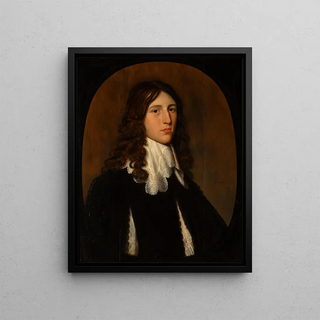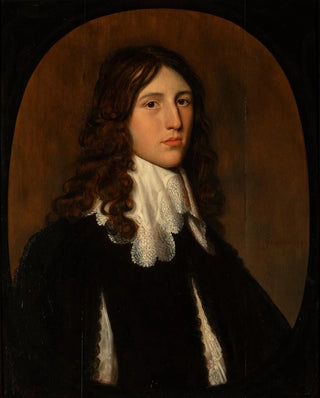Art print | Portrait of Willem van Beveren 1624-1672 - Gerard van Honthorst


View from behind

Frame (optional)
In the fascinating world of baroque art, the art print of Willem van Beveren, created by Gerard van Honthorst, stands out for its intensity and expressiveness. This work, painted between 1624 and 1672, reveals not only the undeniable talent of the artist but also the soul of a man whose gaze seems to capture the mysteries of his time. The light, omnipresent in Honthorst's works, plays a crucial role here, enveloping the subject in an almost divine aura. This portrait, both intimate and solemn, invites the viewer to delve into Willem van Beveren's personal universe while offering a glimpse of the social and aesthetic conventions of the era.
Style and uniqueness of the work
Gerard van Honthorst's style is characterized by an exceptional mastery of light and shadow, a technique known as chiaroscuro. In the "Art print of Willem van Beveren," this technique is implemented to emphasize the features of the subject's face, while creating a dramatic atmosphere. The palette chosen by the artist, composed of warm and rich tones, enhances the depth of Willem's gaze and the texture of his clothing. The latter, carefully dressed, reflects not only his social status but also a particular attention to the fashion of his time. The composition, although classic, exudes a modernity that transcends centuries, making this work timeless and captivating.
The artist and his influence
Gerard van Honthorst, known for his skill in capturing moments of life with an almost photographic precision, established himself as one of the masters of Dutch baroque. Trained in Utrecht, he was influenced by artists such as Caravaggio, whose work on chiaroscuro profoundly shaped his artistic approach. Honthorst managed to incorporate these elements into his own style, creating works that combine realism and spirituality. His impact on his contemporaries and future generations is undeniable, making him a central figure in art history. The "Art print of Willem van Beveren" perfectly illustrates this ability to blend technique and emotion, demonstrating

Matte finish

View from behind

Frame (optional)
In the fascinating world of baroque art, the art print of Willem van Beveren, created by Gerard van Honthorst, stands out for its intensity and expressiveness. This work, painted between 1624 and 1672, reveals not only the undeniable talent of the artist but also the soul of a man whose gaze seems to capture the mysteries of his time. The light, omnipresent in Honthorst's works, plays a crucial role here, enveloping the subject in an almost divine aura. This portrait, both intimate and solemn, invites the viewer to delve into Willem van Beveren's personal universe while offering a glimpse of the social and aesthetic conventions of the era.
Style and uniqueness of the work
Gerard van Honthorst's style is characterized by an exceptional mastery of light and shadow, a technique known as chiaroscuro. In the "Art print of Willem van Beveren," this technique is implemented to emphasize the features of the subject's face, while creating a dramatic atmosphere. The palette chosen by the artist, composed of warm and rich tones, enhances the depth of Willem's gaze and the texture of his clothing. The latter, carefully dressed, reflects not only his social status but also a particular attention to the fashion of his time. The composition, although classic, exudes a modernity that transcends centuries, making this work timeless and captivating.
The artist and his influence
Gerard van Honthorst, known for his skill in capturing moments of life with an almost photographic precision, established himself as one of the masters of Dutch baroque. Trained in Utrecht, he was influenced by artists such as Caravaggio, whose work on chiaroscuro profoundly shaped his artistic approach. Honthorst managed to incorporate these elements into his own style, creating works that combine realism and spirituality. His impact on his contemporaries and future generations is undeniable, making him a central figure in art history. The "Art print of Willem van Beveren" perfectly illustrates this ability to blend technique and emotion, demonstrating






